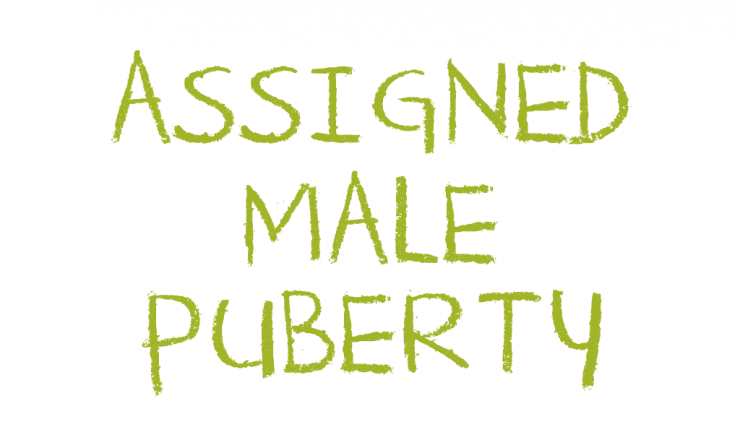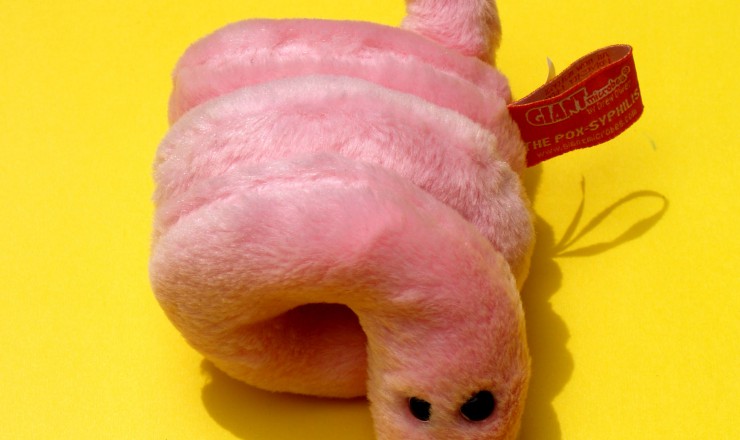Period Products
Periods can be hard to navigate, especially when you include the ever-expanding world of menstrual* products! There are a lot of factors that go into finding what is the best fit for you. This factsheet covers some basics of different period products.
Periods and Stigma
Even though periods are totally normal, they are still often talked about in ways that suggest they are something to be embarrassed about. This has built up over history, with negative messaging coming from many different areas of life. Because of this, many people feel uncomfortable asking for help when it comes to periods and period products. This discomfort can be more intense for trans people, who may feel alienated by how conversations about periods are often directly linked to femininity and being a woman. In an effort to recognize that people of all genders can get periods, you may notice more places using terms like “Period Products” or “Menstrual Products” instead of something like “Feminine Products.”
Periods are when your body sheds the uterine lining (endometrium) that has built up over your menstrual cycle. This is a normal part of life if you have a vagina* and a uterus*. It’s totally okay for people to have a lot of different feelings about their own periods. However, it is not okay for another person to make you feel ashamed or embarrassed about your periods.
For info on periods, check out our page on Period Basics.
Things to Consider
There are a number of things you might consider when deciding which period product works best for you. While some methods are more common or popular, the goal is finding something that fits with your body and that you feel comfortable with. You might consider:
Managing flow.
Some products use words like Light, Regular, Super, Super Plus or Ultra to describe how heavy of a flow they are designed to manage. Knowing which products are a good fit for your period may take some experimenting. It is common to use different products as the heaviness of your flow varies throughout your period.
Inside or outside?
Are you comfortable inserting something into your vagina? Are you comfortable touching menstrual blood? Period products can go inside or stay on the outside of your body, and which one you choose might depend on your physical or emotional comfort.
Are you okay with others knowing that you’re on your period? Products worn outside of your body can potentially be seen by others who see you in your underwear. Other people may notice if you’re carrying extra tampons or pads with you.
Environmental impact.
Is this method reusable? Can you make your own? People with a talent for sewing may want to try to make their own reusable pads or period underwear. This is cheaper than buying disposable ones, and it’s a way to help the environment.
Cost and access.
Most period products can be found at drug stores, pharmacies, grocery stores, etc. Eco-friendly options are often available at health food or natural goods stores. Sometimes you can order online directly from the manufacturer’s website. (Manufacturer websites may also have info on how to use a particular product.) Some period products are available for free at clinics like Planned Parenthood Toronto, city-run homeless shelters, drop-in and respite centres, as well as some neighbourhood or community centres.
The Products
Quickly Compare
| Cost | Lifespan | |
| Tampons | • $5-15/Pack | • 4-6 hours per use |
| Pads | • Single Use: $5-10/Pack • Reusable: $5-25/Pad |
• 4-8 hours per use • Reusable pads can last up to 5 years |
| Menstrual Cups | • $20-40/Cup | • 12 hours per use • Some cups can last 10+ years |
| Menstrual Discs | • Single Use: $20/8-pack • Reusable: $40/Disc |
• 12 hours per use • Reusable discs can last for years |
| Period Underwear | • Single Use: $7/3-pack • Reusable: $30-50/Pair |
• Same as non-period underwear • Meant to be washed or thrown out after use |
| Material | How is it worn? | DIY? | Difficulty Level | |
| Tampons | • Cotton or other fibers | • Inside | • No | • Medium |
| Pads | • Cotton or other fibers | • Outside | • Yes | • Low |
| Menstrual Cups | • Medical grade silicone | • Inside | • No | • Medium |
| Menstrual Discs | • Medical grade silicone | • Inside | • No | • High |
| Period Underwear | • Cotton or other fibers | • Outside | • Yes | • Low |
Tampons
Tampons are rolls of cotton or other fibers that are inserted into the vagina to absorb menstrual blood. They may come with plastic or cardboard applicators, or be inserted with just your fingers. Cardboard applicators are usually cheaper but plastic ones may be easier to use, especially your first time.
How do I use it?
- Try finding a comfortable position to insert, like sitting or standing with a leg up on a chair or stool.
- Remove the applicator from the package and pull out the plunger. Insert the tampon applicator into your vagina with the tampon inside, and push the plunger to get the tampon deeper inside your vagina. Remove the applicator. You can also insert a tampon by pushing it into your vagina with just your fingers (no applicator). Things to make insertion easier include relaxing your body, going slow and taking deep breaths. Tampons may be harder to insert when your vagina is dry or your flow is light.
- The tampon string should hang outside the vagina. You won’t be able to feel the tampon inside you. If you can still feel it, you may not have inserted it up far enough in your vagina.
- After 4-8 hours, pull the tampon out by the string and throw it in the garbage.
Pads
Pads (sometimes called sanitary napkins) are thin pieces of cotton or fiber that are placed inside your underwear to absorb menstrual blood.
How do I use it?
- For disposable pads, stick adhesive side onto the inside crotch of your underwear. If the pad has wings, they fold down around the crotch of your underwear. Reusable pads do not typically have any adhesive, so they fasten to your underwear with snaps or other fasteners according to the style of the pad.
- After 4-8 hours, or sooner if you feel discomfort or are bleeding through the pad, remove the pad from your underwear. Single-use pads can be thrown in the garbage. Reusable pads can be put in the washing machine or washed by hand in cold water. They can be hung up to dry or put in a dryer, depending on the fabric.
- Some pads are specifically designed for overnight use. They are typically more absorbent, so that you don’t need to get up in the night to switch pads.
Menstrual Cups
Menstrual cups are rounded cups made out of medical grade silicone that are inserted into the vagina. Instead of absorbing blood, they catch and collect it to be disposed of later.
You may have to try a few different cups before you find the right one for you. Most brands offer multiple sizes, including options if you have a low cervix. Some people have a couple of different sizes of menstrual cups that fit or feel better at different times during their period, or use different sizes of cups for different activities (e.g., playing sports, sleeping, etc.).
How do I use it?
- The method for inserting a menstrual cup may vary depending on the kind you have.
- Try finding a comfortable position to insert, like sitting or standing with a leg up on a chair or stool. Things to make insertion easier include relaxing your body, going slow and taking deep breaths. Cups may be harder to insert when your vagina is dry or your flow is light. You can use a small amount of lube if it helps.
- Fold your cup whichever way makes insertion more comfortable for you. They are designed to fit upright in the vagina. Cups open a bit once in place. The cup stays inside by suction, which also prevents leaks.
- To remove, break the suction seal by pinching the cup or pulling on the stem (depending on the cup). Pull it out using the stem. All fluids can be dumped straight into the toilet.
- Cups can be cleaned with unscented soap and water. It is recommended to do this once every 12 hours while in use. Cups should not go in the dishwasher. Cups can be sanitized by boiling in hot water, or de-stained by leaving overnight in water with denture cleaner.
- It is generally okay to use a cup even if you also have an IUD. The suction of the cup does not affect the IUD. You may want to remove the cup slowly so you can feel if you are pulling on the IUD strings with your fingers. You can ask your clinician to trim the strings if you feel you are at risk of pulling on them. Your clinician may recommend waiting a while to use your cup after IUD insertion: ask what they recommend.
Menstrual Discs
Menstrual discs are discs made of flexible plastic or medical grade silicone that are inserted into the vagina. They are designed to catch and collect fluid to be disposed of later.
Choosing the right disc depends largely on which one feels most comfortable. They mostly only come in one size, so trying different brands may be the best way to get a sense of the different options.
How do I use it?
- The method for inserting a menstrual disc may vary depending on the kind you have.
- Try finding a comfortable position to insert, like sitting or standing with a leg up on a chair or stool. To make insertion easier try relaxing your body, going slow and taking deep breaths. Discs may be harder to insert when your vagina is dry or your flow is light. You can use a small amount of lube if it helps.
- Squeeze the sides together and put it lengthwise into your vagina. Discs sit on a bit of an angle, covering the cervix and tucked behind the pubic bone. They expand a bit as they fill.
- To remove, pull the rim of the disc. Discs tend to be messier than cups and involve more contact with menstrual fluid. All fluids can be dumped straight into the toilet.
- Reusable discs can be cleaned with soap and water. It is recommended to do this once every 12 hours while in use. Reusable discs should not go in the dishwasher.
- Disposable discs can be thrown in the garbage after use.
Period underwear
Period underwear are thicker underwear that provide protection against leaks during a period. Some involve extra-absorbent or waterproof lining, or are designed to help keep pads in place.
Period underwear comes in lots of different sizes and styles. Some are better for different activities (e.g., playing sports, going out, sleeping, etc.)
How do I use it?
- Period underwear is worn like regular underwear.
- It can be used on its own or as backup for other menstrual products (tampons, pads, cups, discs, etc.).
- Period underwear should be cleaned following manufacturer directions, as it will depend on the style or materials used. Typically they can be machine-washed and hung up to air dry.
- Disposable period underwear can be thrown in the garbage after use.
Health and cleaning
- Try to wash your hands before and after inserting or applying period products.
- It is normal for your vagina to smell different during your period. Soaps and menstrual products that are fragranced can cause drying or irritation.
- The vagina is self-cleaning and does not need any special soaps, cleaners or douches, even during your period. These may disturb the natural, normal balance of bacteria found in your vagina, and can cause vaginitis (inflammation of the vagina).
- Period blood can stain clothing or other fabrics. Some options for removing stains include using cold water and rubbing stains out with salt, baking soda, hydrogen peroxide, or lemon juice, or oxygenated bleaches specifically designed for stain removal. Treating stains before putting them in the washing machine can help them wash out completely.
Toxic Shock Syndrome (TSS) is caused by toxin-producing bacteria that can live in the vagina. While the risk of TSS is very low, it’s slightly greater for people using tampons. Tampon-users can reduce risks by:
- Changing tampons at least once every 4 to 8 hours.
- Using the lowest absorbency possible for your flow and adjusting absorbency or switching products as your flow changes.
- Considering other methods like cups or discs.
General notes on period products
- Period products are not flushable and should be thrown out in the trash. Flushing them down the toilet is likely to cause clogged pipes or other plumbing problems. They can be wrapped in toilet paper or newspaper before being put in the garbage.
- Insertable products (tampons, cups, discs) can’t get lost inside your body. If your menstrual product gets stuck, for example, if you can’t find the string of a tampon, you may have to reach inside your vagina (or higher inside your vagina than usual with some products) with your fingers to pull it out. Check in with a clinician if you are still unable to remove it.
- If you do not have any period products on hand when your period starts, you can line your underwear with toilet paper or facial tissue until you’re able to get a more specialised product. It is not recommended to insert toilet paper or tissue into your vagina as it can be hard to get it all out again afterwards, which can cause infections or other health complications.
- Menstrual sponges are not currently widely available in Canada, but can be ordered online. They work similarly to tampons, and are made of synthetic foam or natural, biodegradable sea sponge.
- Some period products are designed to be used during penetrative vaginal sex (discs, sponges). It is your choice whether you want to use period products during sex. Period products do not protect against pregnancy or STIs.
Resources
Please Note: Most resources about periods and period products use very gendered language.
- On the Rag – A Guide to Menstruation
- DIY Cloth Menstrual Pads
- How to Make Your Own Reusable Menstrual Pads
- Making Cute Period Panties
- Put a Cup In It: Menstrual Cups FAQ
- Put a Cup In It: Menstrual Cups vs Menstrual Discs
- Put a Cup In It: Menstrual Discs
- Menstrual Cup Previews: Reusable Pads
- Menstrual Cup Previews: Period Panties
- Menstrual Cup Previews: Sponges
If you have questions about this topic, feel free to contact one of our peer educators. [Link]
*We know that these aren’t the words everyone uses for their bodies (eg. trans folks), and support you using the language that feels best for you
Last Edited: August 2020







